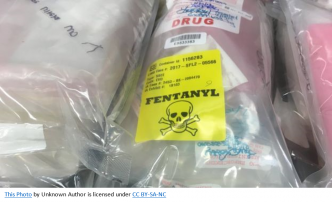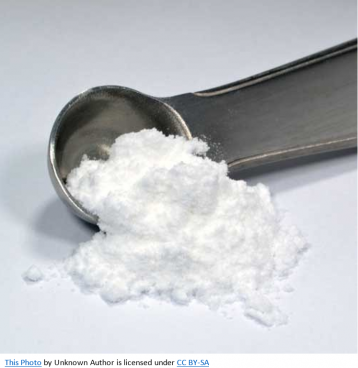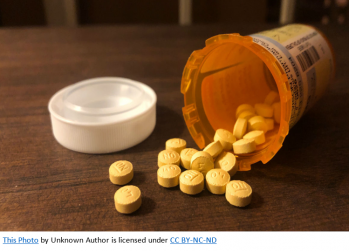 By David R. Shorey, East County Program Manager, Institute for Public Strategies
By David R. Shorey, East County Program Manager, Institute for Public Strategies
Photo courtesy USDOJ
December 7, 2023 (San Diego’s East County) -- There's no denying the urgency of addressing the opioid and fentanyl epidemic, which has claimed the lives of countless Americans. In the shadows of this crisis, another equally destructive menace is still lurking: methamphetamine abuse. We must continue to recognize that the methamphetamine crisis is very much alive, and we can't allow our focus on opioids to divert our attention from this problem that continues to claim lives and ruin communities.
 Data from the past five years show a distressing trend. The San Diego County Substance Use and Overdose Prevention Taskforce (SUOPT) 2023 Report Card shows a 244% increase in methamphetamine non-fentanyl-related deaths from 2018 to 2022. The 2022 deaths accounted for 62% of non-fentanyl-related fatalities, up from 57% in 2018. The Report Card highlights the populations most affected by methamphetamine overdose by saying “In 2022, those with the highest methamphetamine overdose death rates were males, those aged 55-64 years, and non-Hispanic Black residents.”
Data from the past five years show a distressing trend. The San Diego County Substance Use and Overdose Prevention Taskforce (SUOPT) 2023 Report Card shows a 244% increase in methamphetamine non-fentanyl-related deaths from 2018 to 2022. The 2022 deaths accounted for 62% of non-fentanyl-related fatalities, up from 57% in 2018. The Report Card highlights the populations most affected by methamphetamine overdose by saying “In 2022, those with the highest methamphetamine overdose death rates were males, those aged 55-64 years, and non-Hispanic Black residents.”
 The data demonstrates that East County communities represent a significant portion of deaths by showing the ZIP codes with the “highest rates of methamphetamine overdose deaths were 92101 (Central Region - Central San Diego), 92040 (East Region-Lakeside), and 91977 (East Region-Spring Valley).” The methamphetamine crisis is far from over. It's thriving, and its effects ripple through our society, affecting individuals, families, and communities in profoundly.
The data demonstrates that East County communities represent a significant portion of deaths by showing the ZIP codes with the “highest rates of methamphetamine overdose deaths were 92101 (Central Region - Central San Diego), 92040 (East Region-Lakeside), and 91977 (East Region-Spring Valley).” The methamphetamine crisis is far from over. It's thriving, and its effects ripple through our society, affecting individuals, families, and communities in profoundly.
Meth Use Among Arrestees
 Arrestees with methamphetamine in their systems have been rising steadily. While they may not reach the staggering levels seen with opioid and fentanyl-related offenses, the impact is no less devastating. According to the most recent data from the San Diego Association of Governments, adult males and females who tested positive for methamphetamine in their system when entering jail showed a 50% increase over the past 22 years. Methamphetamine seizures in recent years have been in the thousands of pounds with a 2,000-pound seizure occurring in February of this year. Ongoing drug seizures by federal agents point to an alarming trend that demands our attention and intervention.
Arrestees with methamphetamine in their systems have been rising steadily. While they may not reach the staggering levels seen with opioid and fentanyl-related offenses, the impact is no less devastating. According to the most recent data from the San Diego Association of Governments, adult males and females who tested positive for methamphetamine in their system when entering jail showed a 50% increase over the past 22 years. Methamphetamine seizures in recent years have been in the thousands of pounds with a 2,000-pound seizure occurring in February of this year. Ongoing drug seizures by federal agents point to an alarming trend that demands our attention and intervention.
 While opioids and fentanyl may dominate the headlines, methamphetamine is silently taking lives. We need to understand that methamphetamine abuse is not merely a problem of the past but a stark and present danger. The impact on our healthcare system is also on the uptick. The SUOPT Annual Report states that methamphetamine emergency department encounters increased from 17.1% in 2018 to 21.6% in 2021 (2022 numbers will be available in 2024). Methamphetamine-related complications and overdoses put a substantial strain on our healthcare resources. It is a burden that affects us all, both economically and in terms of the quality of care.
While opioids and fentanyl may dominate the headlines, methamphetamine is silently taking lives. We need to understand that methamphetamine abuse is not merely a problem of the past but a stark and present danger. The impact on our healthcare system is also on the uptick. The SUOPT Annual Report states that methamphetamine emergency department encounters increased from 17.1% in 2018 to 21.6% in 2021 (2022 numbers will be available in 2024). Methamphetamine-related complications and overdoses put a substantial strain on our healthcare resources. It is a burden that affects us all, both economically and in terms of the quality of care.
It’s Complicated
 It's essential to acknowledge that methamphetamine abuse is a complex issue with its unique challenges. Unlike opioids, which often start with legitimate prescriptions for pain management, meth is a synthetic drug manufactured in illegal labs, making it more challenging for authorities to control. Meth is highly addictive with no medically assisted treatment that is consistently effective. The physical and psychological toll it takes on users is severe, often leading to destructive, erratic behavior. Meth has a profound impact on public safety, as well as individual and family well-being.
It's essential to acknowledge that methamphetamine abuse is a complex issue with its unique challenges. Unlike opioids, which often start with legitimate prescriptions for pain management, meth is a synthetic drug manufactured in illegal labs, making it more challenging for authorities to control. Meth is highly addictive with no medically assisted treatment that is consistently effective. The physical and psychological toll it takes on users is severe, often leading to destructive, erratic behavior. Meth has a profound impact on public safety, as well as individual and family well-being.
We must first recognize that it is not an either-or situation. The opioid, fentanyl and methamphetamine crises are interconnected in several ways, often with individuals facing all three challenges simultaneously. We cannot neglect one issue in favor of another. Instead, we must implement a comprehensive approach that addresses all drug problems.
Raising Awareness
 To tackle the methamphetamine crisis effectively, we must start by raising awareness and reducing the stigma surrounding methamphetamine addiction. Just as with opioids and fentanyl, addiction is a disease that needs treatment, not judgment. We need to understand the scope and severity of the problem, and we must allocate resources to provide access to evidence-based treatment programs. Prevention and education initiatives should also be a key focus, targeting both youth and adults to deter people from trying meth in the first place.
To tackle the methamphetamine crisis effectively, we must start by raising awareness and reducing the stigma surrounding methamphetamine addiction. Just as with opioids and fentanyl, addiction is a disease that needs treatment, not judgment. We need to understand the scope and severity of the problem, and we must allocate resources to provide access to evidence-based treatment programs. Prevention and education initiatives should also be a key focus, targeting both youth and adults to deter people from trying meth in the first place.
Local law enforcement agencies play a vital role in combatting methamphetamine abuse, and their efforts must be supported and strengthened. Communities need to work hand in hand with law enforcement to identify and dismantle meth production and distribution networks. A multidisciplinary approach, including social services and mental health support, is essential to address the underlying issues that often lead individuals to methamphetamine use. It's crucial to invest in rehabilitation and recovery programs tailored to the unique needs of methamphetamine users. The path to recovery from meth addiction is challenging, and we must provide the necessary resources to ensure that those who seek help can access it.
Moral and Social Obligation
While the opioid crisis deserves the attention it has received, we cannot afford to overlook the ongoing and growing concerns of methamphetamine abuse. We cannot let this issue remain in the shadows. Our communities and individuals are suffering, and we have a moral and social obligation to address this crisis head-on. We must not allow the spotlight on opioids to eclipse the very real and present danger of methamphetamine abuse. We can and must confront both challenges with equal dedication, compassion, and resources to ensure the health and well-being of our communities. It's time to acknowledge the hidden crisis, raise awareness, and act to combat methamphetamine abuse in our midst.
 IPS works alongside communities to build power, challenge systems of inequity, protect health and improve quality of life. IPS has a vision for safe, secure, vibrant and healthy communities where everyone can thrive. To learn more about IPS East County, follow us on our social media platforms: IPS East County Facebook, IPS East County X, and East County Youth Coalition Instagram. Our website is at IPSEast.org. Resources and services are available to assist with screening, treatment, and recovery for individuals with a substance use disorder via the Access & Crisis line, which is open year-round, 24/7 at (888) 724-7240 or just dial 988.
IPS works alongside communities to build power, challenge systems of inequity, protect health and improve quality of life. IPS has a vision for safe, secure, vibrant and healthy communities where everyone can thrive. To learn more about IPS East County, follow us on our social media platforms: IPS East County Facebook, IPS East County X, and East County Youth Coalition Instagram. Our website is at IPSEast.org. Resources and services are available to assist with screening, treatment, and recovery for individuals with a substance use disorder via the Access & Crisis line, which is open year-round, 24/7 at (888) 724-7240 or just dial 988.


















Comments
We're on a spiral to the bottom